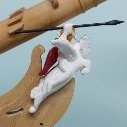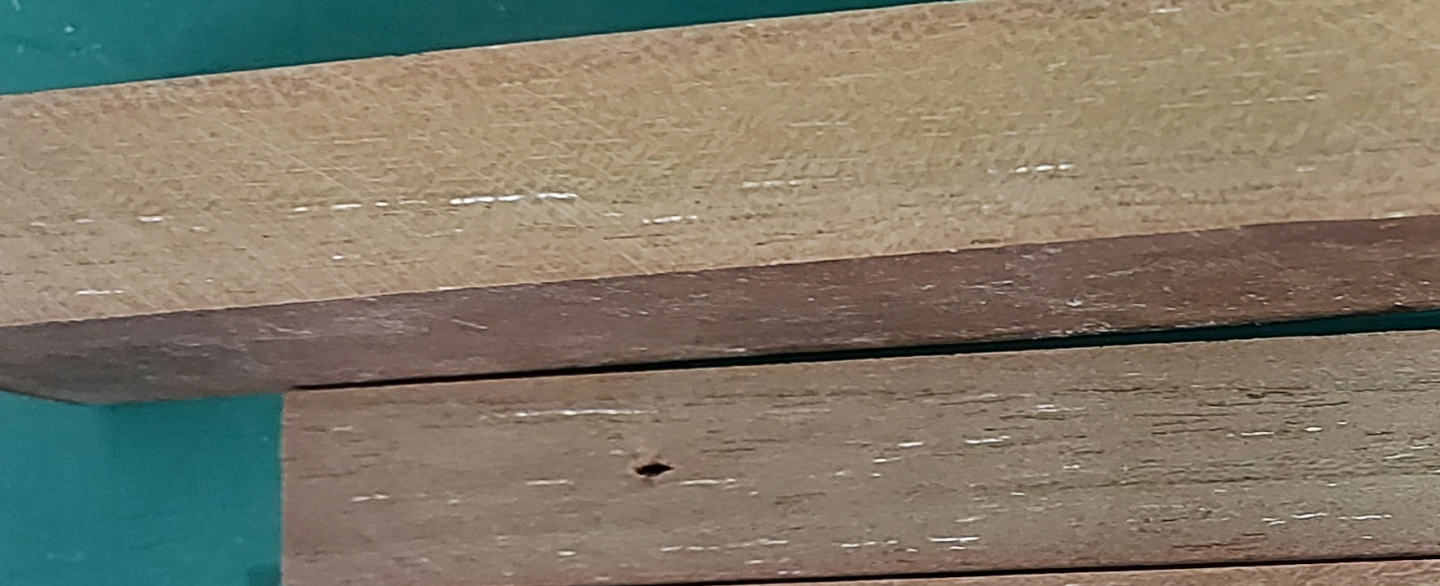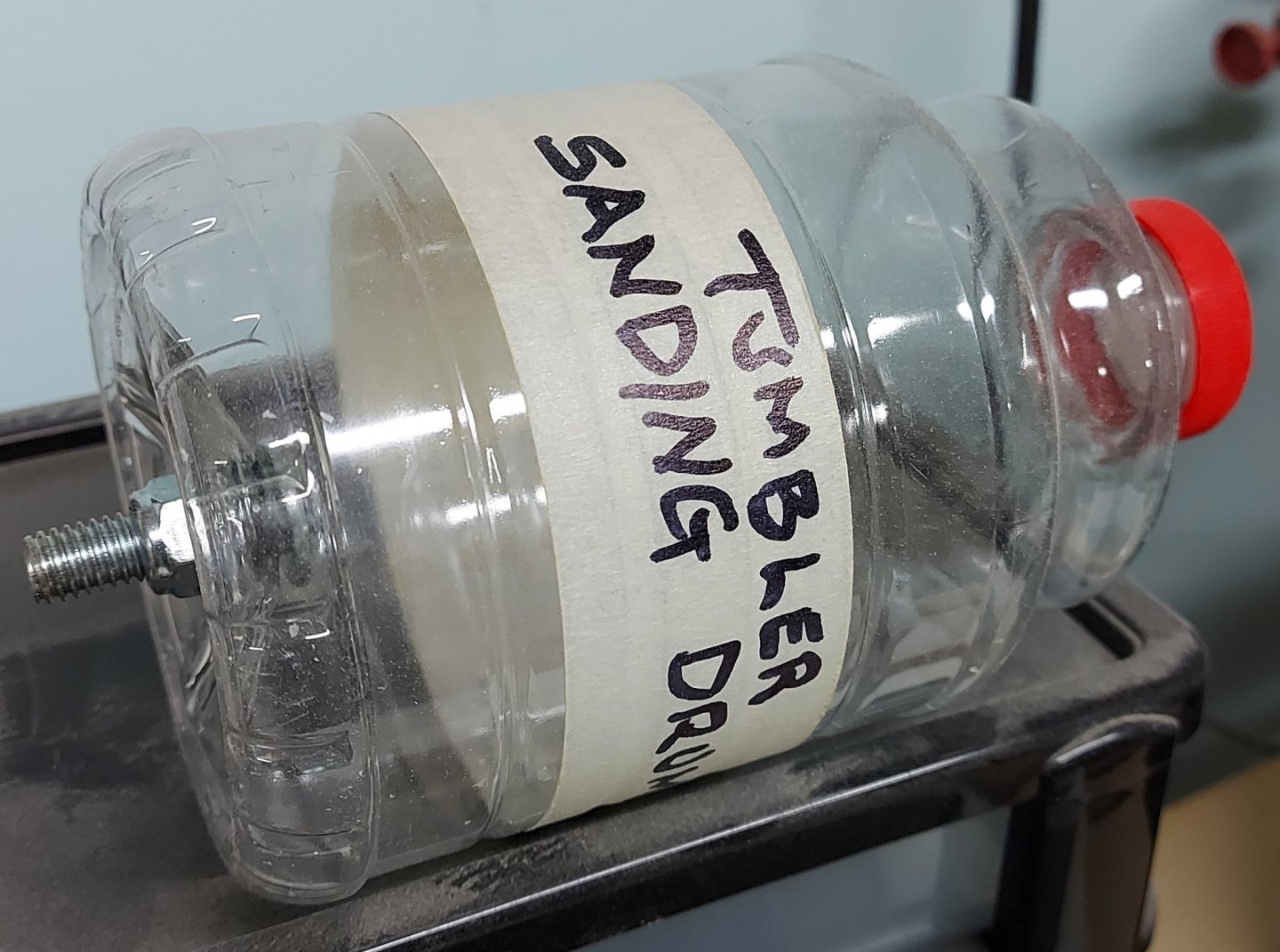-
Posts
2,841 -
Joined
-
Last visited
Content Type
Profiles
Forums
Gallery
Events
Everything posted by AON
-
from google search: Unbleached Titanium White is a warm beige tinted white. This oil paint can be used to lighten colors with a different effect than regular whites.
-
I have been given a very small quantity of wood (one piece 1" x 4" x 12" or 25.4 x 101 x 305mm) and I haven't a clue what it is. Can anyone help me identify it. it is a more dark than light shade of brown, with short streaks of white in it. The surface was stained and the end has something like a glue on it so I cannot see the end grain. I cut a few strips as I thought I'd use it but then I saw the actual colour pattern and now it's got me wondering. There is no specific scent and no appreciable weight to it.
-
Sorry about that each image was uploaded with the source in it's name... eg: Truss Parrel pg105-5 (-5 means 5th image from the page) The Masting + (and) Rigging of ESOW (English Ships of War 1625-1860 by James Lee) If you copy them out you will have the info I thought for some reason it would display if you hovered your mouse over them
-
there are a couple more but I fear I may be pushing things a bit with my photos from Index - The Masting and Rigging of English Ships of War 1625-1860 by James Lee:
-
-
here is some more info from The Masting and Rigging of English Ships of War 1625-1860 by James Lee, pgs 66 and 67
-
does this help? Top Gallant Yard from The Masting and Rigging of English Ships of War 1625-1860 by James Lee, pg 95
-
Now that you're re-organized you'll never be able to find anything. 🤣
- 1,103 replies
-
Thanks for the info Mike It looked like the glue was in the hole first and seemed awkward.
- 967 replies
-
- hahn
- oliver cromwell
-
(and 1 more)
Tagged with:
-
Mike Do you put a dab of glue in the drilled hole and then inset the treenail, or do you chamfer the lead corner of the treenail as a leader to help initial insertion and apply a dab of glue to the end of the treenail then insert it?
- 967 replies
-
- hahn
- oliver cromwell
-
(and 1 more)
Tagged with:
-
Regarding the name I almost passed on looking at your build but then thought I was being stupid... after all, some ships were renamed two or three times. I had no idea what your ship might be. I am glad I took a peek. Alan O'Neill (From the Irish County Cork O'Neills)
- 967 replies
-
- hahn
- oliver cromwell
-
(and 1 more)
Tagged with:
-
I had the idea weeks ago to make a sand tumbler. I saved a Orville Redenbacher Popcorn plastic bottle and screw top, and drilled a hole in the base for a bolt. I slipped a flat washer and O-ring over the bolt to seal it to the bottle base to keep the sand in. I intend to get a small bucket of clean beach sand to use in the "tumbler", but haven't made it out to the shore of Lake Erie just yet (a 30 minute drive). I'd fill the container about quarter full to start and slip the bolt into my wood lathe set to it's slowest speed. Toss in some scrap bits with holes drilled through for a test run. To empty it I'd dump the contents back into the bucket with a screen/sieve to catch the parts. I got the idea from fluidized bed furnaces and hopper screw augers used to remove debinded casting sand from Solution Furnaces. The former had sand flow like a fluid through every crack and crevice to heat treat gears, bolts, golf clubs, etc.. The latter seemed to be self cleaning via sand rubbing against the hopper and chute. So I imagine the sharp edges of the tiny sand grains would wear away and soften the edges of blocks, grooves and holes. All I need now is the darned sand.
-
FYI The official response from DREMEL regarding their right angle drill attachment and their flex-shaft: "Unfortunately, the right angle and the flex shaft are both attachments for our rotary tools, but are not compatible with each other." Seems like a missed opportunity and short sightedness on the part of their engineering and marketing group... and so I suggested they might want to get their design group working on it. Of course I expect no action, but will be pleasantly surprised if a year and a half from now it is offered.
- 967 replies
-
- hahn
- oliver cromwell
-
(and 1 more)
Tagged with:
-
You, like others I follow, are well ahead of me (which is a good thing for me!). I was in the shop drilling holes with the dremel and flex-shaft when I took a break and read the update on your build from my phone. The dremel was dangling there in front of me. I did a quick search and some came up (but read on). If you can use your homemade mini drill in the space, holding it in your hand (fingers?) I imagined a dremel attachment might not be much more difficult. When I went upstairs later I did a better search on my computer and I am not certain they make one for the flex-shaft or for number size drills. They seem to only connect directly to the Dremel unit. I've contacted Dremel to ask. I have an ancient model that doesn't come up on their drop down menus for filling in their forms. Mine has replaceable brushes that I could not find on the website. YIKES. (I should have asked about that also).
- 967 replies
-
- hahn
- oliver cromwell
-
(and 1 more)
Tagged with:
-
I wonder if a dremel with a 3 foot flexible cable and a 90° drill attachments would be a good alternative. FYI: My first flex cable burnt through the casing as I didn't know it needed to be taken apart and coated with grease occasionally. The next one has lasted me 20 years.
- 967 replies
-
- hahn
- oliver cromwell
-
(and 1 more)
Tagged with:
-
I starting draughting in high school, grade 9. I had draughting classes for all four years. Went to college for 3 more years and was exempted from engineering drawing (draughting). On graduating I got a job in 1975 as a junior draughtsman, on a draughting board... and found out how much I didn't know. After years of training I was a senior draughtsman. We had tall sitting stools at our tables but rarely used them. We also did "napkin sketches"... now there is a lost art. One fellow made left and right gremlin foot print stamps (toes and all) from two erasers and when you came in in the morning you'd find graphite foot prints across your drawing sheet. I did pencil and ink drawings back then, but in came computers with AutoCAD. I miss seeing the draughtman's dance: doing a few lines, standing back to review the work, stepping forward to fix or add to it. With these computers everything was 2D and I eagerly climbed on board. No more graphite smudges on my drawings. The other plus was everyone's lettering was crisp clear and identical. It was beautiful until you had to revise someone else's drawing and found they used umpteen separate short lines when one long line would suffice. I could never get use to sitting all day. When the option came to use a standing table I jumped at that. I would have loved to have a treadmill but the boss wouldn't spring for that. So I went for a walk every day at my break instead. Then came 3D and my pet peeve for numerous short lines was exponentially increased as the darned programmes don't believe in a single line anywhere. Don't get me wrong, I love 3D draughting. If you've ever had to clean an area for clarity, it is a nightmare. So retirement came just at the right time for me. Now I use the Standard version of DraftSight (annual subscription) for my love of draughting, and the free hobbyist version of Fusion 360 for my love of 3D modelling (and preparing files for 3D printing). I had a 4 foot draughting table at home but sold that off years ago. I loved SolidWorks but personally found AutoDesk Inventor was a better program... I simply cannot afford the expense in retirement.
About us
Modelshipworld - Advancing Ship Modeling through Research
SSL Secured
Your security is important for us so this Website is SSL-Secured
NRG Mailing Address
Nautical Research Guild
237 South Lincoln Street
Westmont IL, 60559-1917
Model Ship World ® and the MSW logo are Registered Trademarks, and belong to the Nautical Research Guild (United States Patent and Trademark Office: No. 6,929,264 & No. 6,929,274, registered Dec. 20, 2022)
Helpful Links
About the NRG
If you enjoy building ship models that are historically accurate as well as beautiful, then The Nautical Research Guild (NRG) is just right for you.
The Guild is a non-profit educational organization whose mission is to “Advance Ship Modeling Through Research”. We provide support to our members in their efforts to raise the quality of their model ships.
The Nautical Research Guild has published our world-renowned quarterly magazine, The Nautical Research Journal, since 1955. The pages of the Journal are full of articles by accomplished ship modelers who show you how they create those exquisite details on their models, and by maritime historians who show you the correct details to build. The Journal is available in both print and digital editions. Go to the NRG web site (www.thenrg.org) to download a complimentary digital copy of the Journal. The NRG also publishes plan sets, books and compilations of back issues of the Journal and the former Ships in Scale and Model Ship Builder magazines.







